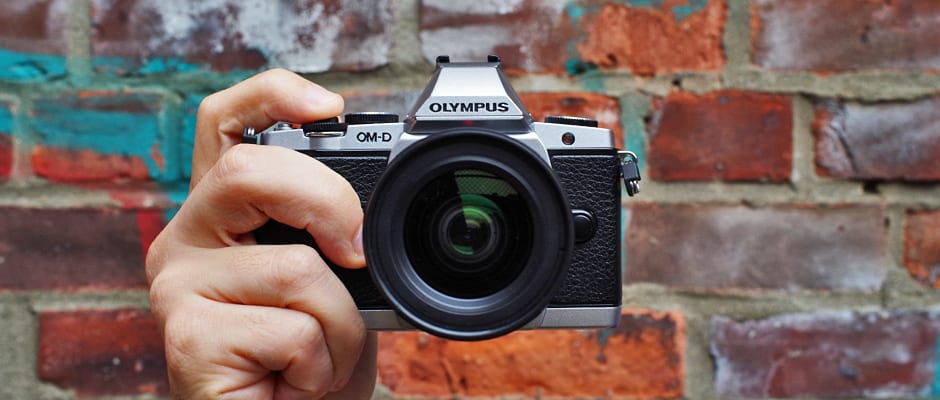Pros
Cons
Introduction
Video Review
{{section_header}}{{section.name}}{{/section_header}}
Kit Lens & Mount
{{section_header}}{{section.name}}{{/section_header}}
The kit lens that we tested our OM-D E-M5 with is the M.ZUIKO DIGITAL ED 12-50mm f/3.5-6.3 EZ lens, with a powered zoom, lens-function button, and on-lens macro button. This lens has a large zoom ring with a very small travel, activating a motor that powers the zoom from wide to telephoto and back again. The standard 14-42mm Micro Four Thirds kit lens is also available, currently priced at $1099.99 with the body. The 12-50mm EZ lens kit is currently priced at $1299.99 with body and lens.
We like the feel of the Olympus lenses, with their sturdy metal construction, ridged focus and zoom rings, and solid weight. The lenses fit the design of the E-M5 very well, so those looking for a camera that is as pleasing to look at as it is to hold will certainly find the lenses appealing. We're not a huge fan of the powered zoom lenses for still photography (the same zoom motion would easily move from 12-50mm in a shorter time span), but for video that ability provides a much more reliable, smooth transition. We should also note that attaching most Micro Four Thirds lenses will not yield a splash- or dust-proof seal as is found on the rest of the camera, so be careful if you're buying the camera for its durability when using alternative lenses.
The E-M5's Micro Four Thirds mount gives it a number of advantages over competing mirrorless systems. First, Micro Four Thirds has seen perhaps the highest adoption rate of any of the mirrorless families, giving it a larger lens library to choose from. Second, the E-M5's weather sealing can be complemented by the use of standard Four Thirds lenses, many of which have that same feature. By opting for the weather sealed Four Thirds lens adapter (which Olympus is offering as a pre-order bonus as of this writing), then you can utilize these older, sealed lenses and not have to worry about getting caught in the rain.
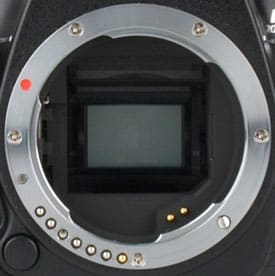
Classic Pentax lenses can be mounted with readily available adapters.
Sensor
{{section_header}}{{section.name}}{{/section_header}}
The sensor on the Olympus OM-D E-M5 is a new Live MOS Micro Four Thirds sensor, with an effective resolution of 16.1 megapixels. As a Micro Four Thirds sensor, it's smaller than your typical APS-C sensor found in similarly-priced DSLRs, but slightly larger than those found in mirrorless cameras like the Pentax Q and Nikon 1-series.
Convergence areas of different sensor sizes compared
Viewfinder
{{section_header}}{{section.name}}{{/section_header}}
The electronic viewfinder on the E-M5 features a resolution of approximately 1.44 million dots. It offers around 100% coverage and an approxiamtely 18mm eyepoint. It's pleasing to use—among the better ones that we've seen on a compact system camera—but it still doesn't quite match up to an optical viewfinder. The benefits of it being electronic, though, are the ability to see shots in playback through the finder, as well as see the relative brightness of your shot before you take it.
Compared to the camera's likely direct competition, the E-M5's viewfinder is more pleasing to use than the finder on the Sony NEX-7. It's a different animal to the hybrid optical/electronic viewfinder on the Fuji X100 and X-Pro1, but both are useful in their own right.
Display(s)
{{section_header}}{{section.name}}{{/section_header}}
As we saw with the similar screen on the Olympus E-P3, the responsiveness of the touchscreen is great, while the OLED renders crisp text and makes colors really pop. The screen sits on an articulating arm that extends outward from the body, with a hinge allowing it to be tilted either upward or down. The only way you can't tilt this display is toward your subject, something the side-hinged displays can do. Unlike those displays, however, the actual LCD housing feels nice and sturdy, with the metal hinge keeping everything steady.
Secondary Display
One thing that we found odd is the implementation of the touchscreen controls on the camera. Even with something with large, easy-to-touch tiles like the camera's super control panel, touching settings doesn't necessarily activate that setting. With a screen this sensitive, it would be nice to have more sliders and things that take advantage of it. Still, as we've seen with most touchscreen cameras, the functionality is best seen in playback, moving between photos as you would on a smartphone or table. Either way, the camera is set up in such a way that you can entirely ignore the touch functionality and not miss out on anything, which is preferred for a camera of this level.
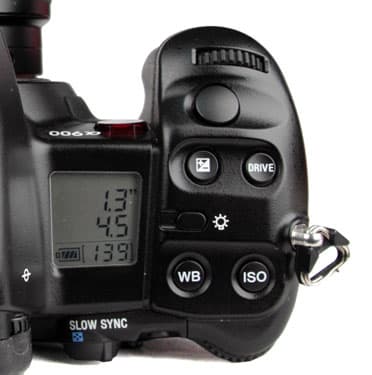
The mono LCD display is small and disappointing.
Flash
{{section_header}}{{section.name}}{{/section_header}}
The Olympus E-M5 does not include a built-in flash, instead relying on a small bundled flash that comes with some iterations of the camera's kit. The bundled flash has a guide number of 10 meters, at ISO 200, with a flash sync speed of 1/180th of a second and slower. The bundled flash can also control wireless flashes, with 4 channels and 4 groups possible (3 groups and the bundled flash).
If you wish to use a larger external flash, the camera does support select Olympus strobes. If you pick up the Exept FL-50R then the flash sync jumps to 1/200th of a second normally, or up to 1/4000th of a second in the reduced power Super FP pulse mode.
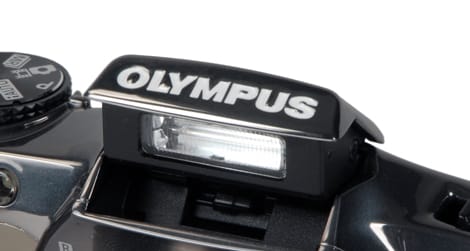
The flash emitter pops up from the top of the body via a mechanical release.
Connectivity
{{section_header}}{{section.name}}{{/section_header}}
The Olympus OM-D E-M5 has both USB and mini-HDMI ports behind a plastic door on the left side of the body. The door can be a little tough to lift, with the catch sitting behind the tilting rear OLED screen. We imagine this helps reduce the likelihood of accidentally leaving the door loose, which would hinder the camera's ability to stay protected from moisture.
Additionally, the E-M5 has a full hot shoe on the top of the body, a standard tripod collar, and an electronic pin setup used for attaching the HLD-6 external (water-resistant) battery grip and holder. This gives you a vertical grip, as well as some extra power for your camera.
Durability
{{section_header}}{{section.name}}{{/section_header}}
The Olympus E-M5 is designed to combat the elements, with weather sealed shields used throughout the body design. Olympus' own press for the camera states that the camera can stand up to heavy rain and blowing sand with the right lenses attached, so it's more than just a little moisture resistant. The one kit lens that meets those standards is the powered zoom 12-50mm EZ lens, though there are 12 such Four Thirds lenses that are built to dust- and splash-proof requirements. To make use of those effectively, though, you'll have to opt for the MMF-3 Four Thirds to Micro Four Thirds lens adapter, which is dust- and splash-proof itself. If you use a third party adapter the lenses may attach, but moisture and sand can seep in.
Photo Gallery
{{photo_gallery "Front Photo", "Back Photo", "Sides Photo", "Top Photo", "Bottom Photo", "Viewfinder Photo 1", "Viewfinder Photo 2", "Display Photo 1", "Display Photo 2", "Secondary Display Photo", "Flash Photo", "Lens Mount Photo", "Lens Photo 1", "Lens Photo 2", "Battery Photo", "Memory Photo", "Ports Photo 1", "Ports Photo 2", "Ports Photo 3", "Ports Photo 4", "Ports Photo 5", "Ports Photo 6", "Modes Photo", "Handling Photo 1", "Handling Photo 2", "Handling Photo 3", "Buttons Photo 1", "Buttons Photo 2", "Mic Photo", "Box Photo"}}
Image Quality
The Olympus OM-D E-M5 features a new 16-megapixel sensor that has greatly improved dynamic range and high ISO performance. It also produces very sharp images, though the camera does dial up the edge enhancement a bit. The one thing we did notice was that color accuracy has taken a bit of a dive compared to the earlier PEN-series cameras, though it's still quite good. Overall, we think the new sensor is a big step forward in terms of image quality for Olympus and we expect to see more of this sensor in 2012's PEN models, in addition to this new OM-D series.
Sharpness
{{section_header}}{{section.name}}{{/section_header}}
We tested the Olympus OM-D E-M5 with its 12-50mm f/3.5-6.3 EZ motorized kit lens. While this isn't the sharpest lens in the Micro Four Thirds stable, it still produced some great results at all but the most extreme settings. Our test images produced some MTF50 results of over 2000 at the maximum aperture, though the minimum aperture and longer focal lengths struggled relative to the lens' performance in other areas.
The Olympus E-M5 did apply some level of edge enhancement to its images, with a slight halo effect around our slanted edge targets coupled with a darker ring beside it. This artificially amplifies the subjective appearance of fine details on test charts, but in more complicated scenes (such as a person's hair in a portrait), this can actually create worse images. In actual real-world shots, this edge enhancement only worked where strong contrast was already present, though in certain modes it gets dialed up a little higher than you may like. Shooting in RAW eliminates this, while we found the portrait color mode also had little of this effect applied to images. More on how we test sharpness.
Image Stabilization
{{section_header}}{{section.name}}{{/section_header}}
The new 5-axis stabilization on the Olympus E-M5 was not that effective at increasing sharpness under our test conditions. When put under a repeated, specific level of horizontal shake (similar to the shake seen when shooting the camera handheld) at 1/30th of a second shutter speeds, the stabilization improved sharpness by only 2.99%. Margin of error aside, that's not a particularly strong result, but it didn't overcorrect or make shots worse.
While you may have better results with the stabilization system anecdotally or in more naturalistic environments, we didn't find that any of the stabilization modes were effective at this test, with all modes (including turning it off entirely) returning an MTF50 of around 320 LW/PH. That's not incredibly sharp, but it's approaching acceptable levels if you just need a quick snap for the web without any fine detail. Again, with a new stabilization system it may be a matter of fine-tuning the performance of some new hardware, and it may work better in the randomness of real life shooting, but our test conditions do not recognize any improvement from the system over simply leaving it off at these particular conditions.
Color
{{section_header}}{{section.name}}{{/section_header}}
In testing the Olympus OM-D E-M5's color accuracy results were acceptable, though they failed to match the best DSLRs on the market. As we've seen with other Olympus mirrorless cameras, there is more of a tendency to favor saturated colors, with more vivid blue and purple hues pushed in most color modes. More on how we test color.
The most accurate color mode by our testing of the E-M5 was the portrait mode, which is fairly typical of cameras of this type. Portrait mode produced accurate skin tones, keeping trouble areas like yellow in line. It still pushed purples and blues though, which should help cheeks appear more rosy and eyes to pop a bit more. In that mode we saw a minimum color error of 2.9, with the other modes producing errors slightly over 3. One thing to note is all the color modes featured a slight bump in saturation above the ideal, with portrait showing a saturation level of 108%.
NOTE: Because of the way computer monitors reproduce colors, the images above do not exactly match the originals found on the chart or in the captured images. The chart should be used to judge the relative color shift, not the absolute captured colors.
{{comparison_bars title="Color Score Comparison", attribute="Color Score", xLabel="Color Score"}}
Color Modes
{{section_header}}{{section.name}}{{/section_header}}
The Olympus OM-D E-M5 offers a small selection of color modes, though the camera allows for a great deal of customization within these modes.
White Balance
{{section_header}}{{section.name}}{{/section_header}}
We found the Olympus OM-D E-M5 featured acceptable white balance results in both auto and custom. It struggled under tungsten lighting conditions, though not to the degree we typically see in most cameras. When you take the time to gather a custom white balance measurement, the improvement is dramatic. Still, in daylight conditions, leaving it on auto white balance produced a similar result.
Automatic White Balance ({{product.raw_scores['Auto White Balance Score']}})
In our white balance test the Olympus E-M5 produced better than normal results under tungsten lighting, but produced slightly cooler results than is typical with fluorescent and daylight tests. In tungsten lighting we saw an error of approximately 1800-2000 kelvin, with that error hovering around 93 kelvin in fluorescent and 120 kelvin in daylight.
Custom White Balance ({{product.raw_scores['Custom White Balance Score']}})
When taking the time to do a custom white balance, we saw the color temperature error stay between 100-300 kelvin, with the worst errors still under tungsten lighting. The camera struggled under white fluorescent as well, surprisingly, with an error of around 230 kelvin. Under daylight conditions the camera did much better, with custom white balance off by just 180 kelvin. Still, the difference between custom and auto is a little unsettling, and we'd recommend relying on auto white balance except under extremely warm or cool lighting.
White Balance Options
{{section_header}}{{section.name}}{{/section_header}}
The E-M5 includes the typical group of white balance presets, with options for auto, custom (two user-savable levels), and direct kelvin entry. The presets cover a range of lighting conditions, including sunny, shadow, cloudy, incandescent, fluorescent, underwater, and flash. You can also assign the function button to work as a one-touch white balance, taking color temperature readings from the center of the frame whenever needed.
Noise Reduction
{{section_header}}{{section.name}}{{/section_header}}
While Olympus' PEN series of mirrorless cameras has always offered superb color rendition, they've generally struggled to keep noise down at the higher ISOs. The OM-D E-M5 seems to have similar problems, but the higher ISO speeds don't suffer from the same runaway noise problems that plagued earlier Olympus sensors. If you plan to go above ISO 1600, though, we recommend turning on noise reduction at some level. More on how we test noise.
Detail Loss
{{section_header}}{{section.name}}{{/section_header}}
With noise reduction kicked all the way to its maximum, you begin to see a loss of some fine details. As in most JPEG images, these are going to be noticeable first and foremost in areas with repeating patterns, such as hair in a portrait or intersecting branches on a tree. From there, areas like foliage are going to get smudged out, along with any small text that might be in your image. If you print the images at a size of 8x10'' or larger, then this will be noticeable. In small prints or if you downsize an image for the web without cropping, you're unlikely to be able to see most of this detail loss.
ISO Options
{{section_header}}{{section.name}}{{/section_header}}
The Olympus OM-D E-M5 features an ISO range that extends from 200-25600 when extended. The sensor's native ISO range is 200-1600, which is where the noise performance is acceptable without having to resort to noise reduction. You can set ISO through the main menu, through the control panel, or via the on-screen guide that pops up when you press the OK button.
Dynamic Range
{{section_header}}{{section.name}}{{/section_header}}
In testing the Olympus E-M5, we have to commend the company for making a great leap forward in their ability to rein in high ISO noise with this new 16-megapixel sensor. When we tested the Olympus E-P3 last year, we loved its physical design and small touches, but we thought the sensor was, to put it kindly, on the way out. The E-M5 is much improved, with far superior high ISO performance.
Even at the shared minimum ISO of 200, the OM-D E-M5 offers a full stop of dynamic range improvement over the E-P3, with just over 6 stops of range available above a high (10:1) signal-to-noise ratio threshold. Compare that to just 5.19 on the E-P3 and you already have a large performance gap. When you start turning up the ISO, though, the difference is even greater, extending as far as two stops at ISO 6400 and above. Despite this improvement, it's still pretty clear that the E-M5's Micro Four Thirds sensor falls a bit behind the best APS-C image sensors found in prosumer DSLRs and high-end mirrorless cameras like the Sony Alpha NEX-7.
We should mention that we test each cameras' JPEG engines, relying on the way they develop RAW shots right in the camera. This does mean that you'll be able to rescue a fair bit of detail from the images by shooting in RAW, processing on a computer, and tweaking settings to your liking. Still, we'd put the OM-D in the above average category for dynamic range, though it's far from the best. More on how we test dynamic range.
{{comparison_bars title="Dynamic Range Score Comparison", attribute="Dynamic Range Score", xLabel="Dynamic Range Score"}}
Noise Reduction
{{section_header}}{{section.name}}{{/section_header}}
While Olympus' PEN series of mirrorless cameras has always offered superb color rendition, they've generally struggled to keep noise down at the higher ISOs. The OM-D E-M5 seems to have similar problems, but the higher ISO speeds don't suffer from the same runaway noise problems that plagued earlier Olympus sensors. If you plan to go above ISO 1600, though, we recommend turning on noise reduction at some level. More on how we test noise.
ISO Options
{{section_header}}{{section.name}}{{/section_header}}
The Olympus OM-D E-M5 features an ISO range that extends from 200-25600 when extended. The sensor's native ISO range is 200-1600, which is where the noise performance is acceptable without having to resort to noise reduction. You can set ISO through the main menu, through the control panel, or via the on-screen guide that pops up when you press the OK button.
Focus Performance
{{section_header}}{{section.name}}{{/section_header}}
Focus on the Olympus OM-D E-M5 is lightning quick, even faster than we saw on the latest series of PEN cameras. It's also startlingly accurate for a contrast detection system. Contrast detection systems, by their nature, have to move past optimal focus in order to ensure maximum sharpness, retreating to the point of highest contrast. That the camera can do so that fast is remarkable, and it gives the E-M5 a leg up on the rest of its competition in the high-end compact system camera market.
Video: Low Light Sensitivity
{{section_header}}{{section.name}}{{/section_header}}
While the Olympus E-M5's 16-megapixel sensor did well in most of our video tests, in the end it is still physically smaller than the APS-C sensors that its competitors have, hindering its low light sensitivity. Still, compared to its mirrorless competition, it didn't fare too poorly. With ISO on automatic (capped by the camera at ISO 3200), we found the E-M5 needed 18 lux of light to render an image that reached 50 IRE on a waveform monitor (about what would be acceptably bright when viewed on a television). This is actually right in line with the Sony Alpha NEX-7, which needed 17 lux to get a similar result.
Chromatic Aberration
{{section_header}}{{section.name}}{{/section_header}}
The Olympus E-M5's 12-50mm EZ kit lens suffered from some basic lateral chromatic aberration in our testing, though only near the edges of the frame and mostly just at the widest angle. By stopping down the aperture or zooming in to a longer focal length, the color fringing dissipated. We mostly saw CA in the form of blue and red fringing near the edges of our chart's slanted edge targets, with the harshest results at the lens' wide focal length and maximum aperture of f/3.5.
Distortion
{{section_header}}{{section.name}}{{/section_header}}
Distortion on the E-M5 was practically non-existent through most of the zoom range with the camera's in-camera distortion correction. This won't necessarily be applied if you're shooting in RAW, though the E-M5 does not have the option to turn off such correction for JPEGs. As we've seen on other Olympus bodies, shooting in RAW or attaching this lens to a Panasonic Micro Four Thirds body will yield worse results. With correction applied we did still see small bits of distortion, with the worst being 0.97% at the wide angle of 12mm. By the midpoint focal length of approximately 31mm this was already gone.
Motion
{{section_header}}{{section.name}}{{/section_header}}
The motion rendition with the E-M5's video was superb, with great clarity, little ghosting, and without much visible artifacting. We did notice some trailing around our monochrome pinwheel, though, with the moire problem a pretty distracting element in our example motion video. Still, the camera is clearly capable of taking some sharp video, though its use of pixel binning seems to have created a bit of a moire animal anytime the camera isn't moving. More on how CamcorderInfo tests motion.
Video Sharpness
{{section_header}}{{section.name}}{{/section_header}}
As we saw in the motion video, our sharpness test confirmed a pretty serious moire issue anytime a pattern of greater frequency than 400 LPPH is captured on video. The result is an ugly moire effect that causes these lines to blur together, resulting in either odd wavy patterns or discoloration, depending on the subject. Much of the detail was still there, however, with our test recording 700 LPPH of sharpness vertically and 600 LPPH horizontally in bright light (650 vertical/600 horizontal in low light at 60 lux). We believe the E-M5 is utilizing some sort of pixel binning or line skipping method of downsizing video from the 16-megapixel sensor to the HD signal, which is creating aliasing errors, resulting in moire. This is a common problem for DSLRs, but it does undo a bit what are some otherwise excellent videos from the E-M5. More on how CamcorderInfo tests video sharpness.
{{comparison_bars title="Video Sharpness Score Comparison", attribute="Video Sharpness Score", comps="video", xLabel="Video Sharpness Score"}}
Low Light Sensitivity
{{section_header}}{{section.name}}{{/section_header}}
While the Olympus E-M5's 16-megapixel sensor did well in most of our video tests, in the end it is still physically smaller than the APS-C sensors that its competitors have, hindering its low light sensitivity. Still, compared to its mirrorless competition, it didn't fare too poorly. With ISO on automatic (capped by the camera at ISO 3200), we found the E-M5 needed 18 lux of light to render an image that reached 50 IRE on a waveform monitor (about what would be acceptably bright when viewed on a television). This is actually right in line with the Sony Alpha NEX-7, which needed 17 lux to get a similar result.
Usability
With the release of a new line of compact system cameras, there was a hope that Olympus might redesign their menu system in a way that isn't brutally obscure to new users. The system is the same as it is on their PEN cameras, with confusing option names and many commonly-used settings hidden inside a custom menu (that is, itself, hidden by a separate option). The camera design itself isn't bad for usability, but we'd recommend the E-M5 mostly for advanced users who will be able to look past the menu's faults and take advantage of the impressive volume of customization options that the camera offers.
Automatic Features
{{section_header}}{{section.name}}{{/section_header}}
The Olympus OM-D E-M5 includes mostly automatic modes, with a physical mode dial offering options for program auto, intelligent auto, as well as scene and "art" modes. While each of these modes let the camera automatically determine proper exposure settings, the intelligent auto mode will switch to a specific scene mode when it feels that's appropriate. The program automatic will merely try to balance brightness according the metering modes set, while art and scene modes have specific effects that the user can select.
Buttons & Dials
{{section_header}}{{section.name}}{{/section_header}}
The buttons on the E-M5 are designed to be highly water-resistant, which has clearly resulted in an increased travel length, likely due to the rubber seals where the buttons attach to the body. Pressing any of the buttons requires a little more concerted pressure, and some of the buttons become difficult to engage as a result. The playback and Fn1 buttons on the back, for example, are very difficult to push because of the rear thumb rest. Even when you do get ahold of the buttons, the lack of a haptic or audible response means you're not always sure when you've actually pushed the button in yet or not.
Effects, Filters, and Scene Modes
{{section_header}}{{section.name}}{{/section_header}}
The E-M5 features scene modes, art filters, and color modes, all of which can be applied to either subtly or dramatically alter your images.
Menu
{{section_header}}{{section.name}}{{/section_header}}
As we stated above, the menu design on the E-M5 is the same as on the PEN series of cameras, which is among the more confusing that we've seen on the market. For absolute beginners who just want to point-and-shoot, it's not so bad because the custom options they want nothing to do with are inside of the custom menu. Unfortunately, there are also some very commonly used options in this same menu, and it's possible to hide it altogether.
Even if you want to flip through the custom menu, there are literally dozens of options organized only into a loose association of pages. It's a bit of a nightmare if you're looking for specific menu options. Eventually you'll figure out where everything is, but we can only imagine a beginner trying to find his or her way in this menu and getting hopelessly confused.
Instruction Manual
{{section_header}}{{section.name}}{{/section_header}}
The E-M5 comes with a paper basic manual that goes over the basics of getting started with the camera, recording images, changing settings, and recording videos. The camera also comes with a more advanced manual, but it's located on the included CD-ROM along with Olympus' VIEWER 2 software. The manual covers just about everything you' need to get started shooting with the camera, with clearly labeled diagrams and step-by-step instructions for accessing features.
Handling
{{section_header}}{{section.name}}{{/section_header}}
When you pick up the Olympus E-M5, it's a little surprising how light the camera actually is. With a body made almost entirely out of magnesium alloy, you'd think that it would weigh more than 15 ounces with battery and memory card. While the body has a definitively industrial feel, the grip is quite comfortable, if a little slick. It's more substantial than the grips on any of the PEN-series cameras, with only a slight inward curve to accommodate the hand. The one serious complaint we'd have to register is the hanging strap eyelets, which make a racket and constantly get in the way, unless you have the strap attached and around your neck. It's a minor annoyance, but it's a design flaw that has appeared on several Olympus cameras over the years.
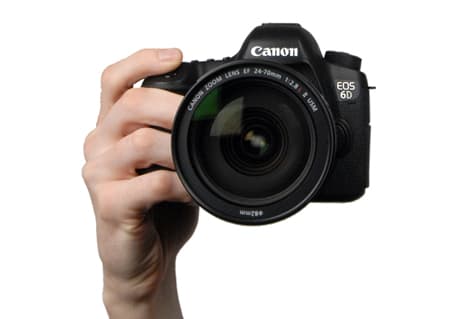
The shutter on both the body and the battery grip are nice, though like the other buttons on the camera they have a relatively long travel before they are considered engaged. This makes the buttons on the back of the camera difficult to press, especially the Function 1, playback, and INFO buttons. With a rather expansive menu system, not having the ability to rapidly navigate around is a bit of a pain. In particular, the "OK" button on the back is difficult to really press, and none of the buttons offer much of an audible click when activated.
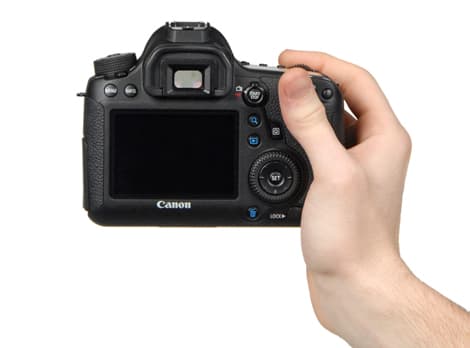
With the optional HLD-6 battery grip attached, the Olympus E-M5 also handles quite well. The one odd thing about it, though, is the placement of the lens. When shooting normally, the lens is a little bit to the left of the camera. When you turn it on its side with the attached battery grip and holder, the lens ends up being lower than you'd expect, meaning you have to angle your portraits slightly.
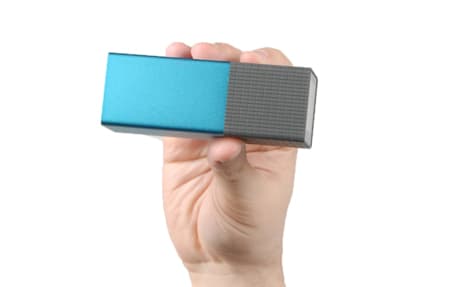
Buttons & Dials
{{section_header}}{{section.name}}{{/section_header}}
The buttons on the E-M5 are designed to be highly water-resistant, which has clearly resulted in an increased travel length, likely due to the rubber seals where the buttons attach to the body. Pressing any of the buttons requires a little more concerted pressure, and some of the buttons become difficult to engage as a result. The playback and Fn1 buttons on the back, for example, are very difficult to push because of the rear thumb rest. Even when you do get ahold of the buttons, the lack of a haptic or audible response means you're not always sure when you've actually pushed the button in yet or not.
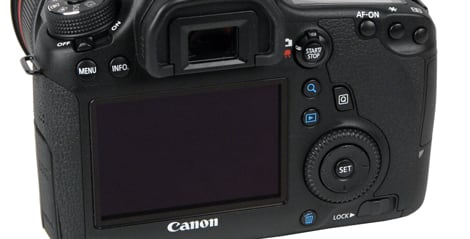
We should note, however, that the three dials on the camera are all well-designed, with just the right amount of resistance. The mode dial doesn't feature a locking mechanism, but it has more resistance than the other two dials on the top plate of the camera, so accidentally switching modes is unlikely. The two top plate dials are (mostly) unlabeled, but they give you enough control that, even if you're a full manual shooter, you'll be able to confidently adjust exposure settings at will.
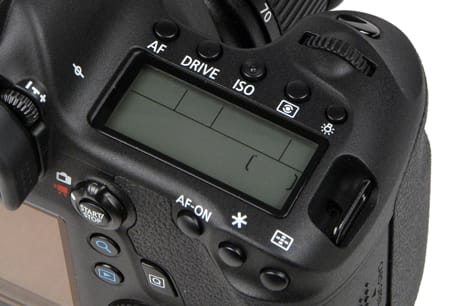
Display(s)
{{section_header}}{{section.name}}{{/section_header}}
As we saw with the similar screen on the Olympus E-P3, the responsiveness of the touchscreen is great, while the OLED renders crisp text and makes colors really pop. The screen sits on an articulating arm that extends outward from the body, with a hinge allowing it to be tilted either upward or down. The only way you can't tilt this display is toward your subject, something the side-hinged displays can do. Unlike those displays, however, the actual LCD housing feels nice and sturdy, with the metal hinge keeping everything steady.
Secondary Display
One thing that we found odd is the implementation of the touchscreen controls on the camera. Even with something with large, easy-to-touch tiles like the camera's super control panel, touching settings doesn't necessarily activate that setting. With a screen this sensitive, it would be nice to have more sliders and things that take advantage of it. Still, as we've seen with most touchscreen cameras, the functionality is best seen in playback, moving between photos as you would on a smartphone or table. Either way, the camera is set up in such a way that you can entirely ignore the touch functionality and not miss out on anything, which is preferred for a camera of this level.

The mono LCD display is small and disappointing.
Viewfinder
{{section_header}}{{section.name}}{{/section_header}}
The electronic viewfinder on the E-M5 features a resolution of approximately 1.44 million dots. It offers around 100% coverage and an approxiamtely 18mm eyepoint. It's pleasing to use—among the better ones that we've seen on a compact system camera—but it still doesn't quite match up to an optical viewfinder. The benefits of it being electronic, though, are the ability to see shots in playback through the finder, as well as see the relative brightness of your shot before you take it.
Compared to the camera's likely direct competition, the E-M5's viewfinder is more pleasing to use than the finder on the Sony NEX-7. It's a different animal to the hybrid optical/electronic viewfinder on the Fuji X100 and X-Pro1, but both are useful in their own right.
Image Stabilization
{{section_header}}{{section.name}}{{/section_header}}
The new 5-axis stabilization on the Olympus E-M5 was not that effective at increasing sharpness under our test conditions. When put under a repeated, specific level of horizontal shake (similar to the shake seen when shooting the camera handheld) at 1/30th of a second shutter speeds, the stabilization improved sharpness by only 2.99%. Margin of error aside, that's not a particularly strong result, but it didn't overcorrect or make shots worse.
While you may have better results with the stabilization system anecdotally or in more naturalistic environments, we didn't find that any of the stabilization modes were effective at this test, with all modes (including turning it off entirely) returning an MTF50 of around 320 LW/PH. That's not incredibly sharp, but it's approaching acceptable levels if you just need a quick snap for the web without any fine detail. Again, with a new stabilization system it may be a matter of fine-tuning the performance of some new hardware, and it may work better in the randomness of real life shooting, but our test conditions do not recognize any improvement from the system over simply leaving it off at these particular conditions.
Shooting Modes
{{section_header}}{{section.name}}{{/section_header}}
The E-M5 features a physical dial on the left side of the electronic viewfinder housing on the top plate of the camera. The dial has a ridged edge, with just enough resistance on it as you switch from mode to mode. The dial houses the basic PASM settings, along with intelligent auto, scene modes, art filters, and a dedicated video mode. The program auto P mode is the most basic automatic mode, with the intelligent auto switching to appropriate scene modes when the conditions are right.
Manual Controls
{{section_header}}{{section.name}}{{/section_header}}
The Olympus E-M5 offers an incredible host of manual controls, not just over exposure but also tonal gradation, creative filters, control layout, and focus and metering. Most of these controls are placed in the custom menu, including (curiously) all of the focus modes, methods, and controls that are normally found under just shooting settings.
Focus
{{section_header}}{{section.name}}{{/section_header}}
Focus on the Olympus OM-D E-M5 is lightning quick, even faster than we saw on the latest series of PEN cameras. It's also startlingly accurate for a contrast detection system. Contrast detection systems, by their nature, have to move past optimal focus in order to ensure maximum sharpness, retreating to the point of highest contrast. That the camera can do so that fast is remarkable, and it gives the E-M5 a leg up on the rest of its competition in the high-end compact system camera market.
The E-M5 features plenty of focus modes and methods, with manual focus, single AF, continuous AF, single AF with manual focus adjustment, and continuous AF with manual adjustment. There's also a digital zoom function that will engage when you turn the focus ring to help you lock in focus, with magnification of 5x, 7x, and 10x available.
Recording Options
{{section_header}}{{section.name}}{{/section_header}}
The image sensor in the E-M5 is capable of producing images at a maximum resolution of 16 megapixels, or 4608x3456 pixels. In JPEG that produces a file of approximately 7.5MB, with RAW files lossless compressed at approximately 1/1.5, producing a 17MB file. You can set the camera to produce smaller JPEGs as well with 1/8 compressed 4608x3456, 2560x1920, and 1024x768 options available, producing 3.5MB, 1.1MB, and 0.3MB files respectively.
Speed and Timing
{{section_header}}{{section.name}}{{/section_header}}
The Olympus E-M5 utilizes a computerized focal plane mechanical shutter, but it moves at a pretty spectacular rate. Olympus claims that it is able to fire at up to 9 frames per second in the high speed continuous mode, or 4.2FPS in low speed continuous. The camera also comes with single frame drive modes, as well as self-timers of 12 and two seconds.
You can access the E-M5's many drive modes through the custom menu, or by going through the control panels brought up by pressing the rear OK button. In intelligent auto mode this brings up the live guide, so you'll have to go through the menu in that case. You can also assign drive mode to the down key on the rear control pad, giving you access to this even when using the camera in a fully automatic mode. Also of note, the drive mode being used is tied to the shooting mode selected, so if you change to continuous in program auto and switch to shutter priority, it will return to whatever drive mode was selected last time you were in shutter priority.
The Olympus OM-D E-M5 is blazingly fast, amongst the fastest compact system cameras on the market. We found that its electronically-timed focal plane shutter operated at a rate that averaged out to about 8.5FPS over a five-shot burst in the high-speed continuous, with the fastest shot-to-shot time getting as low as .095 seconds. If you're just counting that fastest rate, that would give the camera a speed of up to 10.5FPS, well above Olympus' claim of 9FPS, so points for honesty on their behalf.
The JPEG buffer is also quite expansive, able to record 16 frames at the fastest rate before slowing down to a more pedestrian speed. The camera processed those files quite quickly as well, though there is a delay between taking that burst and being able to refocus and shoot again. That will shrink with any of the fastest cards, but an approximately 16 frame buffer at 8.5FPS puts the OM-D above the Samsung NX200 and just below the Sony NEX-7 in terms of raw speed. Speaking of RAW speed and awful segues, switching to shooting RAW instead of JPEG still resulted in 14 frames before slowdown, taken at approximately the same 8.5FPS speed.
The self-timer on the Olympus OM-D E-M5 allows for either a two- or twelve-second delay, with the AF lamp blinking to countdown the last few seconds. There's no in-camera intervalometer and the camera body itself does not feature a proprietary shutter release port. The OM-D E-M5 is compatible with the USB remote cable release from Olympus, model number RM-UC1, and can be used with bulb exposures, though we haven't tested this functionality.
Focus Speed
{{section_header}}{{section.name}}{{/section_header}}
Focus on the Olympus OM-D E-M5 is lightning quick, even faster than we saw on the latest series of PEN cameras. It's also startlingly accurate for a contrast detection system. Contrast detection systems, by their nature, have to move past optimal focus in order to ensure maximum sharpness, retreating to the point of highest contrast. That the camera can do so that fast is remarkable, and it gives the E-M5 a leg up on the rest of its competition in the high-end compact system camera market.
The E-M5 features plenty of focus modes and methods, with manual focus, single AF, continuous AF, single AF with manual focus adjustment, and continuous AF with manual adjustment. There's also a digital zoom function that will engage when you turn the focus ring to help you lock in focus, with magnification of 5x, 7x, and 10x available.
Features
While many of the new compact system cameras are designed to appeal to current point and shoot users, there's a new class of cameras that are looking to appeal directly to old-school photography enthusiasts. The E-M5 certainly isn't shy about that fact, as it's the first camera to bring back Olympus' OM-series moniker with digital innards. That isn't to say the E-M5 runs like a retro camera, though, as it has all the conveniences that the best compact system cameras offer, including: electronic viewfinder, articulated OLED touchscreen, and dual control dials. With a very fast autofocus system and 8.5FPS shot-to-shot speed, we think the OM-D is more than just a nice design, but a capable camera that can keep up with the better cameras in this part of the market.
Recording Options
{{section_header}}{{section.name}}{{/section_header}}
The new sensor on the Olympus E-M5 outputs video data at 30fps, which it interpolates into 1080/60i and 720/60i footage in a .MOV container (MPEG-4AVC/H.264 compression). In that format you can elect to shoot at either "fine" or "normal" compression, with bitrates of 20Mbps and 17Mbps, respectively. Also of note: this drops to 13Mbps or 10Mbps when shooting at just 720/60i.
The camera also offers AVI Motion JPEG, with 720/30fps and VGA/30fps options, though if you employ some of the camera's art filters while recording video, that frame rate will slow to around 15fps, creating a flickering effect. The maximum you can record in any of the formats is 29 minutes, with that dropping to 22 minutes when using normal compression for 1080/60i footage.
Video Controls
{{section_header}}{{section.name}}{{/section_header}}
When recording video you have a full host of manual controls that you can use to set exposure prior to recording, including shutter speed, aperture, and ISO. These are locked in once you've pressed the record button, however, so you can't alter shutter speed the middle of a video. Prior to recording you can also set autofocus type, white balance, image stabilization, audio recording (on or off only), and activate face priority mode.
You can access all of these features by pressing the OK button when in the dedicated video record mode. This brings up a sidebar of selectable options, along with a choice for what recording mode you want to be in. This lets you choose various auto exposure programs, like shutter priority mode, aperture priority mode, program auto, or any of the 11 in-camera art filters. You can also simply choose manual mode and set exposure, aperture, and ISO yourself.
Auto Controls
As the E-M5 utilizes an on-sensor metering system, it's capable of utilizing the full automatic exposure modes whenever recording video. In addition, you can apply any of the in-camera art filters, though the effect sometimes slows down the shutter speed such that there is a flickering effect like an old silent film. Also worth noting: the camera's dedicated record button will begin a video in any mode, with any of the settings you currently have set. So you can be in intelligent auto, or program auto, or even the scene modes and pressing record will just begin recording video right away. Through this method you can apply not only the art filters, but the standard color filters as well, including monotone (B&W).
Zoom
Most of the lenses that are available for the E-M5 require manually turning the zoom ring to zoom in and out. If you elect for the E-M5 kit with the 12-50mm f/3.5-6.3 EZ lens, though, the lens' built-in zoom motor will apply a slow, gradual zoom in or out from your subject, which will look smooth on video. One thing to note is that the lens doesn't continually focus while zooming, so you may have to let the camera readjust for focus once zooming in or out.
Focus
The Olympus OM-D E-M5 offers all of the same focus modes for video as it does for stills, including single AF, continuous AF, manual focus, single AF+manual, and continuous subject tracking. The continuous AF worked occasionally while recording video, though we wished it was more sensitive. The camera also seemed to struggle tracking subjects moving around the frame, though it was good at adjusting for depth if a person moved toward or away from the camera. The single AF was, as with most cameras, a little jarring during video. This is because for contrast-detection AF, the lens has to open up all the way to brighten the scene and enable focus. This creates a bright flicker for a second in your video and can be pretty disruptive.
Exposure Controls
When recording video on the E-M5 you are allowed to employ any of the aperture settings that the lens allows for, with shutter speed restricted to anything faster than 1/30th of a second. Manual ISO control is only available when shooting video in the full manual mode, otherwise auto ISO takes over. ISO is only available between 200-3200, with the maximum ISO settings not available.
Other Controls
The E-M5 features a strobing effect during video that is very similar to the famous John Zimmerman Hulcher shot, where a subject in motion continuously strobes in the frame. This can be done while recording video continuously (by pressing the down key on the rear control pad), or at selected times (by pressing the right key on the pad). It creates an interesting effect that would be very difficult to replicate in post with a moving video.
Audio Features
{{section_header}}{{section.name}}{{/section_header}}
The E-M5 features a stereo microphone built into the body on either side of the electronic viewfinder housing. The camera does not have a microphone port or audio level control, however, so you're stuck with that audio unless you opt for Olympus' stereo microphone set, the $89.99 SEMA-1. Also of note: this sucker is loud. With an internal fan humming along the entire way to cool the camera's innards, you will immediately notice when your camera wakes up and goes to sleep. The fan cuts out (or at least drastically slows down) when you begin recording video, but we did notice it on some audio we recording in a quiet room (though that may have been our own air conditioner, and any noise would've drowned it out).
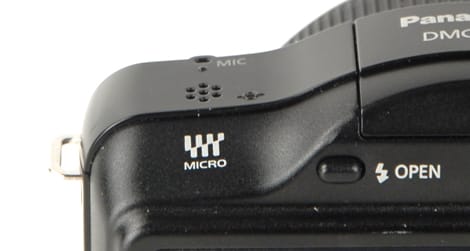
Conclusion
It hasn't taken Olympus long to speed into our hearts with their retro-inspired compact system camera lineup. The Micro Four Thirds PEN series was well-received not only for its style, but its image quality and usability. Seeing a gap at the top of their product line, Olympus now has the OM-D E-M5, answering the question: what would happen if you stuffed modern digital guts in a 1970s compact SLR body?
The E-M5 is the first camera in Olympus' new OM-D line, a direct descendant of their OM line of compact SLR film cameras. It features many of the same components and controls as their PEN E-P3, but with a great electronic viewfinder, mostly magnesium alloy body, and weather sealing that can stand up to rain, wind, and dust.
While we've panned Olympus for relying on too-old image sensor technology in the PEN E-P3 (though it was still our favorite mirrorless camera last year), the E-M5 also features a brand-new 16-megapixel CMOS sensor. According to our testing that sensor provides dramatically improved image quality at high ISOs—a serious performance issue with the older 12-megapixel PEN cameras.
The sensor's noise floor is a bit high, but the camera controls highlights well, offering dynamic range and low light shooting that can keep up with most sub-$1000 DSLRs. While the E-M5 certainly isn't setting any new bars in a category filled with larger APS-C image sensors, it's no longer such an issue that we'd warn you off the camera entirely.
That's especially true given the astonishing speed available in the E-M5. In our speed tests it averaged a little over 8.5FPS, with its best shot-to-shot time touching 10.5FPS territory at full resolution. Also, the E-M5 is able to focus incredibly fast, even in limited light, so you spend less time frustrated at out of focus shots. While the Sony NEX-7 was able to best it for pure speed, we actually found the E-M5 was a better shooter for action because of the focus performance.
It's that responsiveness that gives the E-M5 a fighting chance in an incredibly crowded compact system camera market, with heavy hitters like the NEX-7 and Fuji X-Pro1 hovering just above it in price. If you're looking for a retro-inspired interchangeable lens camera that, like cameras of old, can take some abuse and some great photos at the same time, then the E-M5 is an attractive option at its $1000 body-only price.
Meet the tester
TJ is the former Director of Content Development at Reviewed. He is a Massachusetts native and has covered electronics, cameras, TVs, smartphones, parenting, and more for Reviewed. He is from the self-styled "Cranberry Capitol of the World," which is, in fact, a real thing.
Checking our work.
Our team is here to help you buy the best stuff and love what you own. Our writers, editors, and experts obsess over the products we cover to make sure you're confident and satisfied. Have a different opinion about something we recommend? Email us and we'll compare notes.
Shoot us an email
